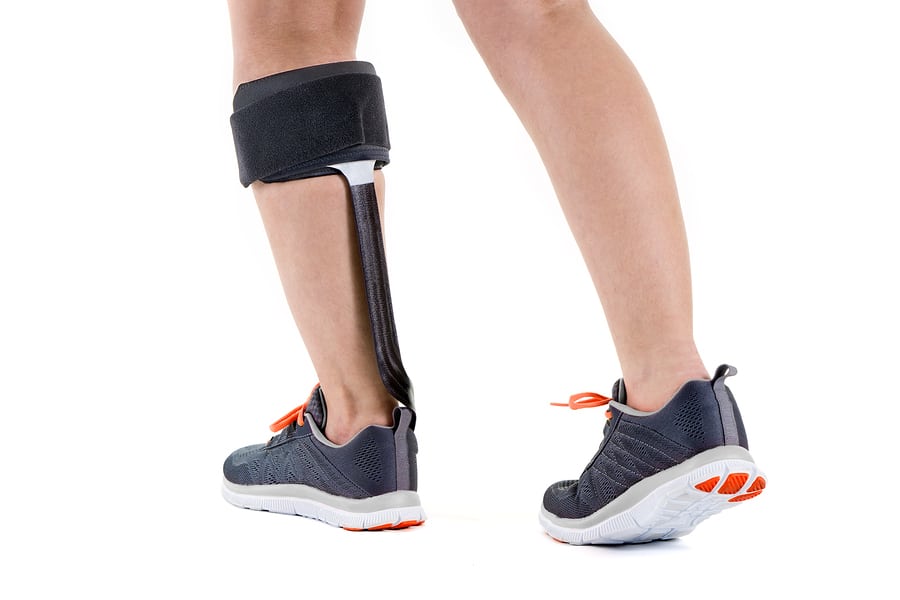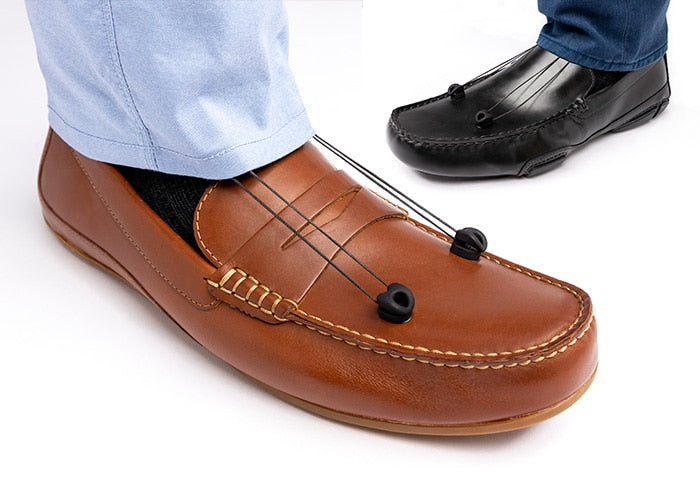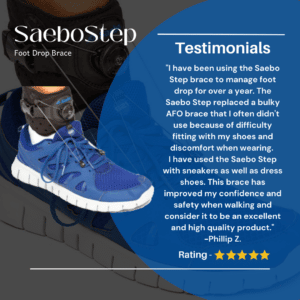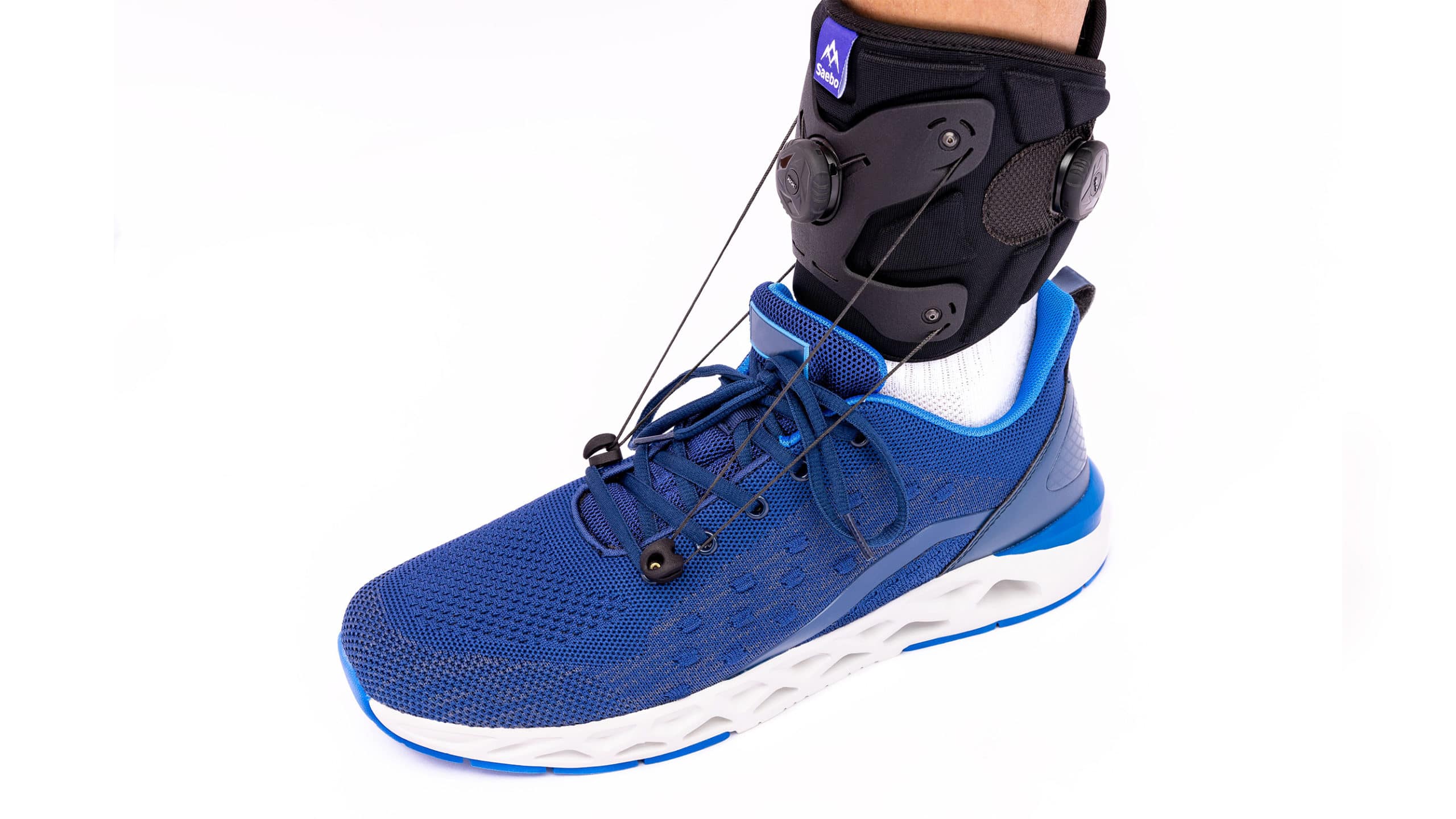How to Find the Perfect Foot Drop Brace/AFO for Foot Drop

Foot drop (or "drop foot") is a common disability, affecting millions worldwide. People suffering from foot drop struggle with limited mobility and have an increased risk of injury from slips and falls. Fortunately, the orthotics market offers a multitude of products engineered to address many different and complex mobility issues. There are many effective foot drop supports, ranging from larger ankle-foot orthosis braces (AFO brace) to versatile external strap-on support systems like the SaeboStep foot drop brace - a state-of-the-art orthotic designed to fit any shoe. This post will describe the condition of foot drop and answer many of the most frequently asked questions about foot drop, what is an AFO brace, and what to consider when shopping for an effective foot drop brace solution.
What is Foot Drop?
Foot drop, also referred to as “drop foot” or “dropped foot,” is a disability marked by difficulty raising the front of the foot, a movement known as dorsiflexion. Dorsiflexion is caused by weakened or paralyzed muscles. Although many stroke survivors suffer from foot drop, other conditions like neurodegenerative disorders or compressed nerves can also cause this symptom.
No matter the underlying cause, patients suffering from foot drop tend to experience similar difficulties with basic, everyday tasks. Individuals experiencing foot drop may have difficulty lifting, turning, or flexing the foot. Consequently, they may drag the affected foot, trip over objects, misstep, or fall. It’s also common for individuals with foot drop to accidentally smack the ground with the affected foot as it lands while walking.
Many individuals with foot drop overcompensate for the loss of dexterity by modifying their typical gait. This may include lifting the leg higher than normal with each step to prevent the foot from dragging or extending the length of stride allowing the heel to land before the front portion of the affected foot. This phenomenon is known as steppage gait and, over time, this gait abnormality can potentially cause other complications and injuries.
What is an AFO/Foot Drop Brace?
Once foot drop has been diagnosed, the attending medical professional will recommend one or more foot drop treatments. Appropriate foot drop treatments and therapies will be specific to each patient depending on the cause and severity of their foot drop. For those suffering from foot drop as a result of a stroke, functional electrical stimulation is a common treatment.
Functional electrical stimulation (FES) uses electrical pulses to restore or improve function in paralyzed muscles, encouraging physical activity. During FES, low-level electrical pulses are used to trigger muscle contractions. Over time, these low-level pulses re-engage the muscles, increasing the chances of recovery from conditions like foot drop.
Physical therapy plays an integral role in the foot drop rehabilitation process, as well. Physical therapy is necessary for strengthening the surrounding muscles of the target area and increasing the overall range of motion. The exercises that therapists provide are designed to increase stability and strength in the foot and lower leg.
In addition to strength training, stretching exercises can increase the range of motion of the ankle joint, potentially resulting in improved gait, posture, balance, and decreased muscle stiffness.

Fortunately, there are many assistive devices on the market to help people suffering from mobility issues caused by foot drop. Ankle-foot orthosis braces (AFO), for example, are designed to minimize foot and ankle flexion by supporting the front of the foot and joint during activity. However, there are key design elements that factor into whether or not a device is appropriate for a specific case.
A traditional AFO brace for foot drop envelops the calf, ankle, and foot to support the front of the foot. There are two primary types of AFO braces. They can be hinged or solid. A solid AFO brace is often used in more severe cases where not only is foot drop an issue, but also spasticity. The goal of a solid AFO brace is to prevent foot drop as well as a contracture. The drawback to this type of orthosis is it limits the amount of range of motion allowed, consequently affecting gait patterns.
A hinged AFO allows free ankle motion, resulting in a more normalized gait pattern and ankle power. However, a hinged AFO is only appropriate if more severe spasticity is not present. Less severe cases of foot drop can be effectively treated with slimmer foot drop braces, like the SaeboStep, which is designed to lift the front of the foot and promote a safer, more natural stride while walking.
For practical and aesthetic reasons, many patients want an outside-the-shoe support system. An external foot drop brace is designed with an adjustable strap just above the ankle, which connects with the front of the shoe to lift the foot and minimize flexion. Compared with low-profile foot drop braces like the SaeboStep an AFO ankle brace for foot drop can take up significant space inside of the shoe.
Due to sizing constraints, people may be forced to settle for a less than optimal shoe style or fit to simply accommodate this larger AFO ankle brace. Outside-the-shoe foot drop braces are usually more comfortable and versatile, allowing individuals to choose the shoe they prefer. Furthermore, these foot drop braces assist with the natural positioning and movement of the foot and ankle, minimizing the stress placed on other parts of the body by steppage gait.
Shopping for an AFO/Foot Drop Brace
Every stride is unique and each case of foot drop will require an individually tailored treatment plan, down to the brace. Here are some questions to ask before purchasing an orthotic or foot drop brace:
- What is the cause of the foot drop? If it is predominately stiffness in the ankle, an AFO may not help.
- Does your ankle or foot move? Hinged AFO’s, or an outside the shoe support, like the SaeboStep, may be more appropriate if there is some movement.
- Is your ankle stable? If you easily roll your ankle, a brace with lateral supports (supports on the outside and inside sides of the foot), may be more appropriate.

- Do you want to wear it inside your shoe? Some support systems, such as the SaeboStep, are designed to be worn outside the shoe.

- What is your budget? Just because an ankle support is expensive, does not necessarily mean it’s the best option for you.
- Is there a trial period after the support system is purchased? Many companies, like Saebo, offer a 30-day trial period.
Put Your Best Foot Forward
Foot drop affects millions worldwide, causing diminished mobility, a lower overall quality of life, slips, falls, and injuries. Anyone struggling with foot drop can benefit from a well-engineered, lightweight foot drop brace. Although the orthotics market is more sophisticated than ever, choosing the best AFO for foot drop for your particular needs should happen with expert guidance and customer service, affordable prices, and the support of the medical community. Here at Saebo, we are committed to stroke support and recovery for all survivors and their families. Saebo offers a wide range of products that combine cutting-edge technology with evidence-based rehabilitation techniques. Our offerings and network of Saebo-trained therapists can help you or a loved one to obtain all the necessary tools to maximize stroke recovery.

All content provided on this blog is for informational purposes only and is not intended to be a substitute for professional medical advice, diagnosis, or treatment. Always seek the advice of your physician or other qualified health providers with any questions you may have regarding a medical condition. If you think you may have a medical emergency, call your doctor or 911 immediately. Reliance on any information provided by the Saebo website is solely at your own risk.




